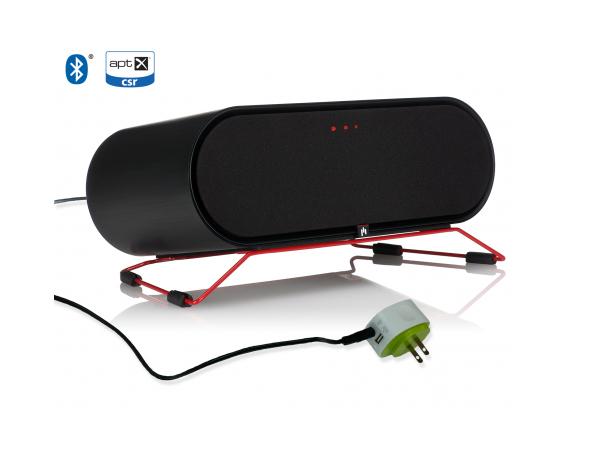So the Roxa supports the aptX codec on the receiving end of the Bluetooth connection. How do I know if my transmitting device supports the aptX codec? My wife has an iPhone 5, I have an HTC EVO 4G (Sprint variant of HTC OneX). The only info I can find on both phones is they are Bluetooth 4.0 compliant. I can't find anything about A2DP or aptX support. Thanks!!
Oh, My Aching Bluetooth!

The ARIS is indeed last year’s news - but last year’s $499 news. Aperion’s Allaire ARIS is this year’s $297 news, a price that turns what was a topnotch desktop speaker system into a phenomenal system for the money. There is a catch, however. At $297, the Allaire ARIS is no longer wireless. (The WiFi card is now a $77 option.) Audio finds its way into the ARIS via an 3.5 mm stereo jack on the back of the speaker; or, as APERION wisely suggests, Apple fans can purchase an AirPort Express for $100 (or so) and instantly make the ARIS AirPlay compatible. Yet, as I expressed early on to Aperion’s Jeanfreau, there was still something achingly missing from the Allaire ARIS: Bluetooth audio connectivity. It wasn’t long before Jeanfreau let me know that he agreed with me and that Aperion has a clever, very affordable, excellent sounding way to numb the pain of the missing Bluetooth.
Perhaps it was because I’d been recently fooling around with Definitive Technology’s Sound Cylinder amazingly good Bluetooth portable speaker. It may also have been the pleasant summer of mowing grass with a pair of almost-cordless Bluetooth earphones. Regardless of what prompted it, while I was waiting for Aperion’s Bluetooth solution to arrive, I couldn’t help but think about how much the uses for Bluetooth have changed since the wireless technology was first created by Ericsson in 1994 - that’s right, Bluetooth is almost old enough to buy booze - to be “a wireless alternative to RS-232 data cables”!
That RS-232 data cable wireless substitute has expanded its usefulness to include connectivity between all sorts of devices; or, as the Bluetooth folks say,
Bluetooth wireless technology is built into billions of products, from cars and mobile phones to medical devices and computers and even forks and toothbrushes.
Yet, as you can imagine, in 1994 audio fidelity wasn’t a top priority for the Bluetooth creators. Short-range, low-power, limited-bandwidth transmission of data was what Bluetooth was all about. Since then, however, Bluetooth has received a number of periodontal updates (called “Profiles”) to make the technology more viable for use in a variety of applications, including audio - most notably with the introduction of the A2DP (Advanced Audio Distribution Profile). A2DP establishes how Bluetooth-enabled devices can stream multimedia audio from one to another. It’s a one-way connection that uses a small pipe for its data flow. Music will invariable get compressed along the way in order to fit the pipeline, and the resulting sound quality will typically be…meh.
There are at least two optional codecs Bluetooth devices can employ to shrink the signal so the A2DP’s default Low Complexity Subband Coding (SBC) has a chance to hack away at it. One is AAC, the codec iTunes uses for music downloads. The other is aptX. According to the developer, CSR,
The aptX audio codec is available for high quality stereo audio over Bluetooth. When incorporated in Bluetooth A2DP Stereo products, aptX audio coding delivers full 'wired' audio quality. With the aptX audio codec source material is transparently delivered over the Bluetooth link, whether it is stored uncompressed or in an alternative compression (MP3, AAC, FLAC) format.
By “full ‘wired’ audio quality”, they mean “audio bandwidth matching CD performance” with “flat frequency response” and “full audio bandwidth faithfully reproduced”.
To be able to take advantage of the better sound quality of either codec, both the transmitting and the receiving devices need to have that particular codec onboard, otherwise the pair will drop down to A2DP’s standard SBC codec to communicate.
There are now a bewildering number of audio products with Bluetooth built-in on the market, although very few of them incorporate AAC or aptX. Just a few of the more unusual examples include:
- Homewerks Worldwide’s Bluetooth-enabled bathroom fan and speaker system combo
- Kohler’s Moxie Showerhead + Wireless Speaker
- OSD’s Bluetooth-enabled outdoor BTR-800 rock speaker and BTP-650 patio speaker
- Hooting Owl Bluetooth Speaker
- Monoprice’s in-wall Self Amplified Digital Keypad w/ Bluetooth and Analog Inputs
While there are quite a few Bluetooth receivers with analog stereo outputs designed to be connected to an audio system or a set of powered speakers, not many include the better codecs. There are several that do, however, and go one step further towards better audio by incorporating a digital audio output as well as the analog audio outputs. Monoprice and Belkin both make excellent Bluetooth receivers with aptX and optical outputs (for under $60, too!), while Mass Fidelity intends on squeezing every last drop of quality out of your Bluetooth connection with the company’s $249 Relay Hi-Fi Bluetooth Receiver.
What was Aperion’s solution to the Allaire ARIS’s Bluetooth gap? After a doing a little research, Aperion discovered the Avantree Roxa Bluetooth 4.0 receiver, and you can now buy the ARIS bundled with a Roxa for $334. (The Roxa is a very affordable $37 add-on.) It doesn’t have an optical output, which is okay since the ARIS doesn’t have an optical input, but the Roxa does include the aptX codec - and it sounds great.
Bluetooth doesn’t always make everything better. In this case, it’s just what the Allaire ARIS needed to make it a killer wireless desktop speaker system.
- Log in or register to post comments





















































